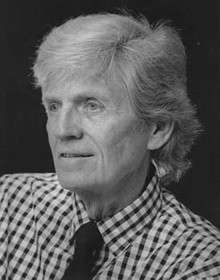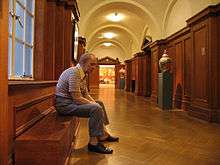Duane Hanson
| Duane Elwood Hanson | |
|---|---|
 | |
| Born |
January 17, 1925 Alexandria, Minnesota |
| Died |
January 6, 1996 (aged 70) Boca Raton, Florida |
| Nationality | American |
| Education |
BA, 1946, Macalester College, Saint Paul, Minnesota MFA, 1951, Cranbrook Academy of Art, Bloomfield Hills, Michigan |
| Known for | Sculpture |
| Movement | Photorealism, hyperrealism |
Duane Hanson (January 17, 1925 – January 6, 1996) was an American artist and sculptor from Minnesota. He spent most of his career in South Florida. He was known for his lifecast realistic works of people. He casted in various materials, including polyester resin, fiberglass, Bondo, and bronze. His work is often associated with the Pop Art movement as well as hyperrealism.[1]
Education
Duane Elwood Hanson was born January 17, 1925, in Alexandria, Minnesota. After attendance at Luther College and the University of Washington, he graduated from Macalester College in 1946. Following a period where he taught high school art, he received a Master of Fine Arts degree from the Cranbrook Academy of Art in Bloomfield Hills in 1951.
Career and style
Around 1966 Hanson began making figural casts using fiberglass and vinyl. Works that first brought him notice were of figures grouped in tableaux, usually of brutal and violent subjects, somewhat similar to the work of Edward Kienholz. Hanson's Abortion (1966) was inspired by the horrors of an illicit backroom procedure,[2] and Accident (1967)[3] showed a motorcycle crash. Race Riot (1969–1971) included among its seven figures a white policeman terrorizing an African American man as well as an African American rioter attacking the policeman. Other works which dealt with physical violence or other explosive social issues of the 1960s were Riot (1967), Football Players (1969), and Vietnam Scene (1969).
These sculptures, cast from actual people, were made of fiberglass, and painted to make the revealed skin look realistic, with veins and blemishes. Hanson then clothed the figures with garments from second-hand clothing stores and theatrically arranged the action. Clearly these works contained strong social comment, and can be seen as modern parallels to the concerns of 19th-century French Realists such as Honoré Daumier and Jean-François Millet, artists Hanson admired.
Few of Hanson's early sculptures would survive because he later destroyed many of them, preferring to be known for his more mature style.[2]
Around 1970, Hanson abandoned gut-wrenching scenes for more subtle, though no less vivid ones. In that year he made the Supermarket Shopper, Hardhat, and Tourists; Woman Eating was completed in 1971. These were also life-sized, clothed, fiberglass figures. Unlike the earlier works, however, these were single or paired figures, and not overtly engaged in a violent activity. Instead, his figures often had a listless, bored affect, staring into the distance and disengaged from their surroundings.
In 1967, art dealer Ivan Karp attempted to persuade Hanson to move from South Florida to New York City, and the artist moved to Manhattan in 1969.[2] However, in 1973, Hanson moved back south, to Davie, Florida, where he would spend the remainder of his life.[2]
While the earlier works tended to be more contained spatially, the later figures had no clearly defined boundaries separating them from the viewer. They quite literally inhabited the viewer's space—with amusing results at times, as in the cases of Reading Man (1977) or Photographer (1978). Hanson sometimes would cast his own children in his work, as in Cheerleader (1988), and Surfer (1987).
Although detractors may liken his work to figures in a wax museum, the content of his sculptures is more complex and subtly expressive than that normally found in waxworks.
Exhibitions

Selected solo exhibitions of Hanson's work include
- Louisiana Museum of Modern Art, Humlebæk, Denmark (1975)
- Berlin Artist Programme Akademie der Künste(1975);
- Des Moines Art Center, Iowa (1977)
- Corcoran Gallery of Art, Washington, D.C. (1978)
- Whitney Museum of American Art, New York (1978)
- Fort Lauderdale Airport, Fort Lauderdale (1990) – Vendor with a Walkman[4]
- KunstHausWien, Vienna (1992)
- Montreal Museum of Fine Arts, Canada (1994, traveled to Modern Art Museum of Fort Worth, Texas)
- Daimaru Museum of Art, Tokyo (1995, traveled to Genichiro-Inkuma Museum of Contemporary Art, Kagawa; and Kintetsu Museum of Art, Osaka);
Posthumous exhibitions:
- Saatchi Gallery, London (1997)
- "Duane Hanson, A Survey of his Work from the 30's to the 90's," Museum of Art, Fort Lauderdale(1998, traveled to Flint Institute of Arts, Michigan; Whitney Museum of American Art, New York; and Memphis Brooks Museum of Art, Memphis)
- "Duane Hanson: More than Reality, 2001,” Schirn Kunsthalle, Frankfurt (2001, traveled to Padiglione d'Arte Contemporanea, Milan; Kunsthal, Rotterdam; National Galleries of Scotland, Edinburgh; and Kunsthaus Zürich).[5]
- "Duane Hanson" at the Serpentine Galleries, London, UK (2015).[6] Crystal Bridges Museum of American Art, Bentonville, AR (2016)
Collections

The following collections hold sculptures by Duane Hanson:[7]
- Boca Raton Museum of Art, Boca Raton, Florida
- Corcoran Gallery of Art, Washington, D.C.
- Cranbrook Art Museum, Bloomfield Hills, Michigan
- Flint Institute of Arts, Flint, Michigan
- Honolulu Museum of Art, Honolulu, Hawaii[8]
- Hunter Museum of American Art, Chattanooga, Tennessee
- Iris & B. Gerald Cantor Center for Visual Arts, Stanford University in Palo Alto, California[9]
- Kresge Art Museum, Michigan State University, East Lansing, Michigan
- Lowe Art Museum, University of Miami, Coral Gables, Florida
- Milwaukee Art Museum, Milwaukee, Wisconsin
- Museum Ludwig, Cologne Germany
- Nelson-Atkins Museum of Art, Kansas City, Missouri
- Pennsylvania Academy of the Fine Arts, Philadelphia, Pennsylvania
- Saatchi Gallery, London, England
- St. Louis Art Museum, St. Louis, Missouri
- Scottish National Gallery of Modern Art, Edinburgh, Scotland
- Smithsonian American Art Museum, Washington, D.C.
- Toledo Museum of Art, Toledo, Ohio
- Whitney Museum of American Art, New York City
- Yale University Art Gallery, New Haven, Connecticut
See also
References
- ↑ Is Duane Hanson the Phidias of Our Time?, Kimmelman, Michael. The New York Times. February 27, 1994.
- 1 2 3 4 "Duane Hanson: An Exhibition of Sculpture, Tools and Accessories, Printed Materials, Models, and Memorabilia from the Collection of Mrs. Duane (Wesla) Hanson". broward.org. Retrieved 3 May 2016.
- ↑ http://www.encyclopedia.com/topic/Duane_Hanson.aspx
- ↑ http://www.broward.org/Arts/PublicArt/PadTour/Inventory/Pages/VendorWalkman.aspx
- ↑ Duane Hanson, October 30 – December 3, 2014 Gagosian Gallery, New York;
- ↑ Duane Hanson, June 02 – September 13, 2015, Serpentine Galleries, London, UK
- ↑ Duane Hanson in AskArt.com
- ↑ Honolulu Museum of Art, wall label, Secretary by Duane Hanson, 1972, cast polyester and fiberglass, polychromed in oil, with found clothing and accessories, chair, accession 14419.1
- ↑ Duane Hanson's Slab man sculpture at Cantor Arts Center, Stanford, California